Materials Science and Engineering: A ( IF 6.4 ) Pub Date : 2020-07-03 , DOI: 10.1016/j.msea.2020.139840 Madan Patnamsetty , Mahesh C. Somani , Sumit Ghosh , Shahroz Ahmed , Pasi Peura

|
In the current study, the hot deformation characteristics and workability of a CoCrFeMnNi high entropy alloy was characterized using processing maps developed on the basis of dynamic materials model in the temperature range 1023–1423 K and strain rate range 10−3 – 10s−1. The processing map delineated various deterministic domains including those of cracking processes and unstable flow, thus enabling identification of a ‘safe’ processing window for the hot working of the alloy. Accordingly, a deterministic domain in the temperature and strain rate ranges of 1223–1373 K and 10−2 – 5 × 10−1s−1, respectively, was identified to be the domain of dynamic recrystallization (DRX) with a peak efficiency of the order of ~34% at 1293 K and 3 × 10−2s−1 and these were considered to be the optimum parameters for hot deformation. The DRX grain size was dependent on the deformation temperature and strain rate, increasing with the increase in temperature and decrease in strain rate, whereas DRX volume increased with the strain rate. At still higher temperatures (1403–1423 K) and lower strain rates (10−3 – 3 × 10−3s−1), there was a sharp decrease in efficiency values from 27% to 5% thus forming a trough and the microstructure was characterized with coarse grains. In the instability regime, grain boundary cracking/sliding and localized shear bands manifested at temperatures <1223 K and strain rates <10−2s−1. The increase in strain rate resulted in an intense adiabatic shear banding along with formation of voids. At 10s−1 and temperatures >1398 K, microstructural reconstitution occurred in the shear bands leading to the formation of fine grains, presumably as a consequence of continuous recrystallization.
中文翻译:

CoCrFeMnNi高熵合金热加工中控制组织和揭示各种变形机理的工艺图。
在当前的研究中,使用基于动态材料模型在1023–1423 K的温度范围和10 -3 – 10s -1的应变率范围内开发的加工图来表征CoCrFeMnNi高熵合金的热变形特性和可加工性。加工图描绘了各种确定性区域,包括裂化过程和不稳定流动的区域,因此能够确定用于合金热加工的“安全”加工窗口。因此,在温度和应变率范围为1223–1373 K和10 -2 – 5×10 -1 s -1的确定性域分别被确定为动态重结晶(DRX)的区域,其峰值效率在1293 K和3×10 -2 s -1时约为〜34%,并且被认为是热变形的最佳参数。DRX晶粒尺寸取决于变形温度和应变速率,其随温度升高和应变速率降低而增加,而DRX体积随应变速率而增加。在更高的温度下(1403–1423 K)和更低的应变率(10 -3 – 3×10 -3 s -1),效率值从27%急剧下降到5%,从而形成了一个波谷,并且显微组织的特征是粗大晶粒。在失稳状态下,在<1223 K的温度和<10 -2 s -1的应变速率下出现晶界裂纹/滑动和局部剪切带。应变速率的增加导致强烈的绝热剪切带以及空隙的形成。在10s -1和温度> 1398 K时,剪切带中发生了微观结构重建,导致形成了细晶粒,这可能是连续重结晶的结果。



























 京公网安备 11010802027423号
京公网安备 11010802027423号